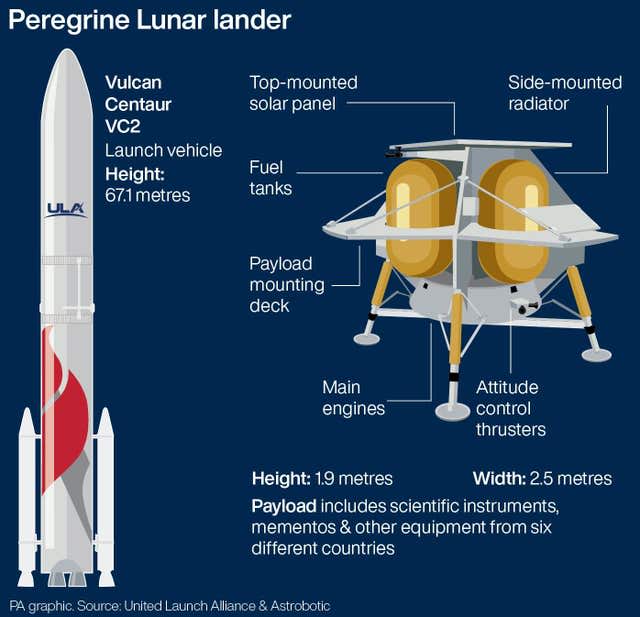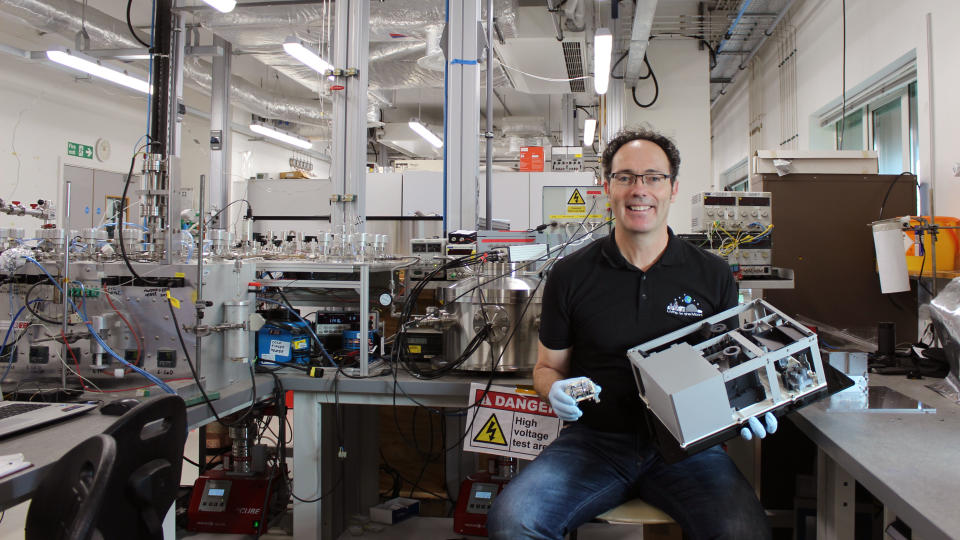A special spacecraft carrying an instrument made by British scientists will make history by starting its journey to the moon.
Peregrine Mission One (PM1), built by US space company Astrobiotic, is set to be the first private probe to land on the lunar surface.
It is also planned to be one of the first U.S. moon landings since Apollo 17, the last mission of the Apollo program more than 50 years ago.
The ship will carry an instrument known as the Peregrine Ion Trap Mass Spectrometer (PITMS), developed by scientists from the UK’s Open University (OU) and Science Technology Facilities Council (STFC) RAL Space, the UK’s national space laboratory.

The instrument will analyze the moon’s thin atmosphere and learn more about how water might move around the moon.
For many years, scientists believed that the Moon was completely dry, and the water detected in samples taken from the Apollo missions was thought to be pollution originating from the Earth.
But more recent missions have revealed the presence of water, and in 2020 NASA confirmed the presence of water molecules in sunny regions of the moon.
From the Open University, Dr. Simeon Barber said: “Various new data over the last decade have overturned the Apollo-era concept of the moon as a bone-dry place.
“We’ve seen traces of ice at the cold lunar poles and suggestions of water (or related hydroxyl molecule) globally, as well as new analyzes of Apollo samples showing small pockets of water within the lunar rock.”
Understanding the lunar water cycle is crucial for future exploration of the moon.
Water is an important resource for sustaining human existence on the moon; In addition to providing drinking water, it also supports various industrial processes.
Dr Barber added: “We are interested in how these water molecules move through the moon’s exosphere (atmosphere) under the influence of day-night temperature cycles and eventually reach the super-cold polar regions, where they slowly accumulate as layers of frost or ice.
“This transport in the exosphere is the link that connects various water bodies, and their ultimate fate is trapped in cold traps at the poles.
“By measuring the composition and density of the lunar exosphere throughout the lunar day, PITMS will allow us to understand the processes occurring on the moon today and, by extension, throughout the history of the moon and other similar planetary bodies.”
The Peregrine lander’s launch window opens at 7.18am UK time on 8 January.
The spacecraft will be launched from Cape Canaveral, Florida, on a Vulcan Centaur rocket built by US aerospace manufacturer United Launch Alliance.
It’s part of NASA’s Commercial Lunar Payload Services initiative, which aims to involve commercial companies in lunar exploration.
The initiative, meanwhile, is part of NASA’s broader Artemis program, which plans to return humans to the moon.
Libby Jackson, head of space research at the UK Space Agency, which has funded £14 million to develop the instrument through its membership of the European Space Agency, said: “The Peregrine Lunar lander will help pave the way for further exploration of our solar system.


“Witnessing the first device from the UK, and indeed Europe, to be launched to the moon is an incredibly exciting moment.
“We look forward to seeing Peregrine safely on the surface and the return of important data from PITMS that will help unlock the secrets of water on the moon.
“It is great to see our talented UK experts at the heart of an international mission that will support a long-term presence in space in the future.”
Chris Howe, production and software group leader at STFC RAL Space, said: “Using lunar water could be vital to future human endeavors in space, so we are incredibly proud and delighted to have the opportunity to help develop PITMS.” to see safely on the road.
Officials say the spacecraft could attempt a Moon landing on February 23, assuming the spacecraft launches on January 8.
Its target is an area in the Gruithuisen Domes, a series of volcanic domes named after German astronomer Franz von Gruithuisen.
The Peregrine lander is designed to operate for approximately two weeks or one lunar day after surfacing.
Mr Howe said: “PITMS’ technology will now help support future missions such as the Rosalind Franklin Rover, so although PITMS will only operate one lunar day per month, its legacy will be felt for years to come.”
Science and Technology Secretary Michelle Donelan said: “The upcoming launch of the Peregrine Lunar Lander reflects the unwavering commitment of our brilliant British scientists working hand in hand with international partners.
“The first British science craft to touch the lunar surface will mark a pivotal moment for the UK space industry and the start of an exciting journey to understand how we can sustain a long-term human presence on the Moon.”